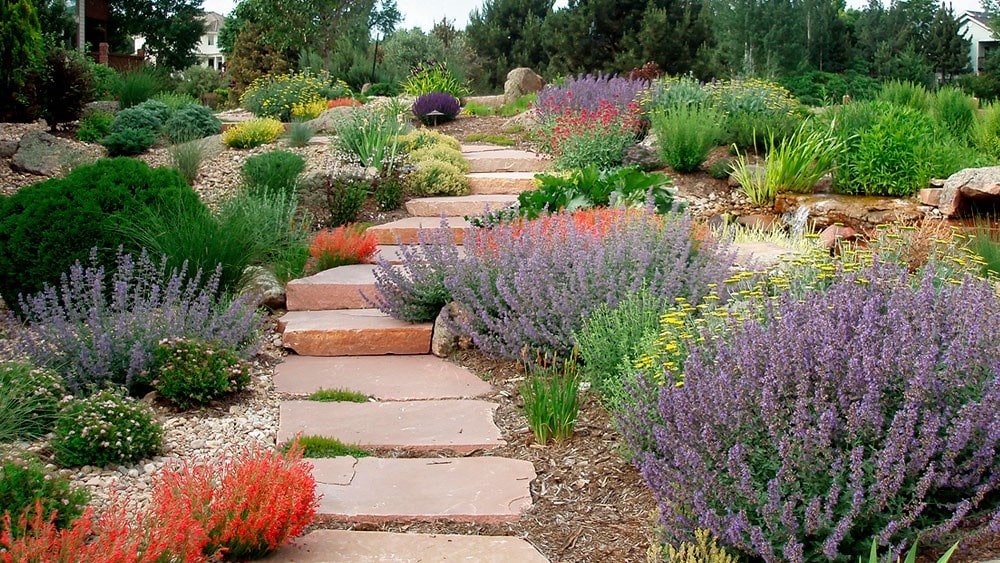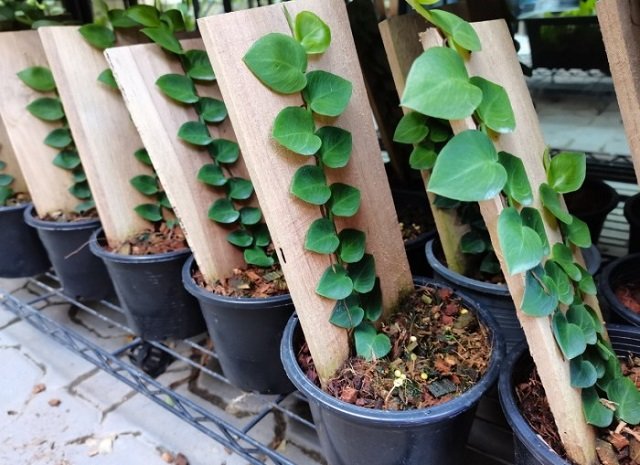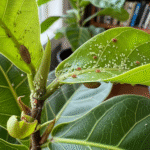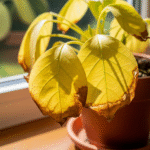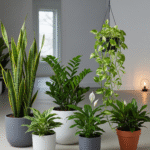What xeriscape plants are?
Plants that have developed several methods for surviving in dry environments, such as narrower and smaller leaf surfaces or deep-dwelling root systems that penetrate the soil for absorbing water are commonly knowns as xeriscape plants.
Xeriscaping was discovered in the 1980s by Denver Water as a technique to maintain aesthetic landscapes while conserving water.
Xeriscape, also known as drought-tolerant landscaping or landscaping that uses less water, is gaining popularity. It had come to be known as the “dry, arid moonscape” for some reason. With xeriscape plants, you can have an aesthetically appealing landscape and save much cost of water and fertilizers at the same time.
If you are a resident of an arid state but still want an uber cool landscape, xeriscaping is the best option for you as xeriscape plants stand hard drought conditions and severe weather changes demanding just a little bit of attention in return, without compromising on the overall look of your front yard.
Advantages of xeriscape plants:
Here are some reasons why you should opt for a xeriscape over a turf landscape.
Budget-friendly:
With xeriscape plants, you can save a whopping 75 to 80 percent of your bills due to little consumption of water. They also minimize the expenses of fertilizers. Plus, it cuts down the requirements of mowing the lawn thus saving the cost of gas to fill your lawnmower.
Xeriscape plants include native plants thriving on acidic soils and rocks which are positively cost-effective than any turf grass landscape. So if you want a classy traditional yard, xeriscape plants are a pocket-friendly deal for you.
Need Less maintenance:
Xeriscape perennials like shrubs, herbs and groundcovers do not need occasional watering i.e. twice or thrice a month, and most of them don’t need water at all after they get mature.
Native drought tolerant plants require less frequent maintenance, mowing or trimming. So, you can have hustle-free and carefree Sundays to enjoy without worrying about your lawn.
Less water consumption:
Many areas of the United States may suffer a reduction in their freshwater supply of up to one-third within the next fifty years. Water shortages are less likely with xeriscape plants since more water can be saved for drinking when less water is used on landscapes.
The outcomes? Some Californian homeowners are cutting their daily water use short by more than 120 gallons. In Flagstaff, Arizona, xeriscaping homeowners save an average of 8,000 gallons of water a year, saving them $275.
Pollution free:
Native plants are adapted to survive in the specific weather and water conditions of your region so you don’t need to use pesticides or fertilizers to maintain them.
By eliminating turf grass, you will be favoring nature by cutting down the need for gas-powered lawn mowers.
Add beauty to your yard:
No doubt green grassy plants look beautiful but in extreme weather changes, they as easily lose their beauty. In strong winds, they are blown away and in hot temperatures, they start wilting, thus they are always struggling to survive.
But as xeriscape plants are native and adapted to severe weather and water changes, they withstand their beauty round the year, providing your landscape an enviable charm.
Adding to biodiversity:
Who does not love butterflies? These wild native plants will attract bees, butterflies and hummingbirds to your garden, thus adding to biodiversity.
You can seek guidance from the native plants’ list of the National Wildlife Federation to know which plants you need for fluttering butterflies in your xeriscape.
Xeriscape plants for Utah
This fact is undeniable that Utah is stricken hard by drought, but neither our homes nor our landscapes must be affected. You can have a beautiful yet low-maintenance, and water-efficient front yard with xeriscape plants.
Good xeriscape ideas are the foundation of great landscapes. We have a number of choices for you that will make you say, “WOW!”
Apache plume:
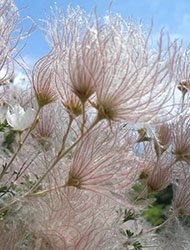
Apache Plume is an evergreen shrub. The most striking and attractive feature of this plant is the feathery reddish seed heads that appear after the five-petaled white rose-like flowers. This shrub can reach 5 feet in height and width in xeriscape settings.
Lavender:

Apart from its amazing scent, lavender can survive drought conditions. You can grow this mound forming perennial in the borders of your front yard and enjoy fantastic mornings. By maximum, it can grow 30 to 40 inches.
Prince’s plume:
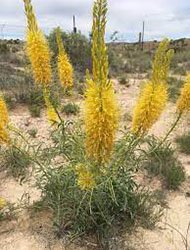
This perennial has developed very good strategies to cope with extreme drought conditions. It has tall plumes of yellow flowers and thick leaves at its base. It can grow up to 5 feet in height.
Gopher plant:

This succulent has a fast growth rate. It has bright green blooms in spring which turn their color to copper in autumn. It is a low-maintenance plant and needs very little water after its establishment. It can spread up to 2 feet tall to 3 feet wide.
Mountain beebalm:
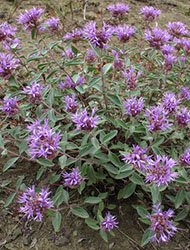
This mound-forming perennial gives off the fragrance of fresh mint. This plant is ideal for rock gardens and is simple to grow and maintain in Intermountain West landscapes. Insects, particularly bees and butterflies, are attracted to its lavender or rose-purple flowers. It can spread up to 1 foot high and 2 feet wide.
Coral bells:
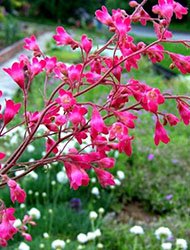
Coral bells, also known as Heuchera are mound-forming perennial herbs. They have flowers of different shades like red, pink and white. They can add brighter hues to your landscape with a variety of colors. These herbs are 1 to 1.5 feet in length.
Mexican cliffrose:
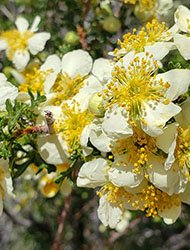
This is an evergreen xeriscape plant that has light yellow flowers. It has an exotic scent that will spread around your yard. Its small, lobed leaves complement its five-petaled flowers. This plant can be as tall as 6 feet and is best for low-water regions like Utah.
Purple prickly pears:

This is a succulent plant from the cacti family. The prickly pears will lend beauty to your landscape by adding bright purple hues and blooming yellow pears in late summers. This is a slow-growing dwarf plant that hardly reaches 4 to 6 inches in length.
Black hens and chicks:

The Black Hens and Chicks (Sempervivum Black) is the best succulent for your xeriscape yard when not grown in containers. They produce white blossoms in summer. Plan for these succulents to remain relatively small as they will spread slowly until they are approximately 12 inches across and 4 to 6 inches tall at maturity.
Blue chalksticks:
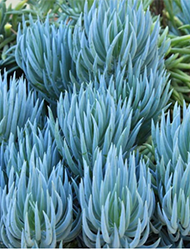
This perennial has finger-like thick succulent foliage which gets a purple touch in hot summers. It is a groundcover plant that needs occasional irrigation and grows at a moderate pace. It covers 2 to 3 feet in diameter being almost 1 foot tall. It also does not require much care.
Xeriscape plants for Colorado
For Colorado landscapes, I highly recommend Xeriscape plants. There are so many options, and I would hate to limit anyone’s palette to just a few, so this is a difficult task. After all, what makes Xeriscaping so appealing is the variety in color, texture, and form.
Having said that, I do believe that a brief list can be helpful to individuals who are new to the area or who are not familiar with the various plant options that are available and may be overwhelmed by a catalog containing thousands of plant options. Even though this is a list for Colorado, you can use most of these xeriscape plants anywhere, depending on the climate.
Fernbush:
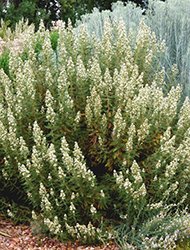
The interesting fern-like leaves of the Chamaebatiaria millefolium remain throughout the winter. Fernbush is a medium-sized shrub, ranging from 6 to 8 feet. This shrub blooms in clusters of small white flowers from late spring to early summer, requiring little irrigation and upkeep.
Fringed Sage:
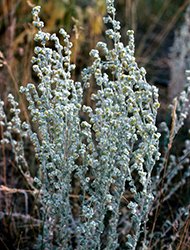
When you see it sparkle in the Colorado sun, you’ll fall in love with it. Fringed Sage is a native to Colorado that can serve as a soil stabilizer, a hardy groundcover, a year-round beauty, and a lovely cohort for the eye-catching flowers you want to put on display in your landscape. It also looks great in the garden year-round. Additionally, it is beneficial to pollinators and repels deer. Its average height is 6 to 15 inches.
Agastache:
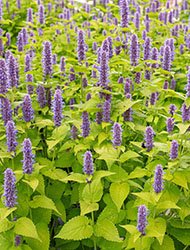
Agastache, often known as hummingbird mint, is a scented family of vibrant perennial herbs that come in a wide range of hues, primarily from orange to pink. From mid-summer to the end of the season, the plants are covered in gorgeous tubular flowers. These plants are incredibly adored by hummingbirds. It grows 2 to 4 feet tall.
Angelina Stonecrop:
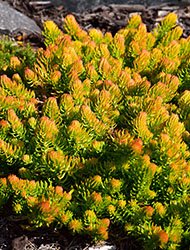
This groundcover is very simple to establish and is drought resistant. The autumnal transformation of the needle-like, chartreuse foliage into orange causes it to spill over a boulder or retaining wall in a stream of color. This groundcover can spread upto 24 inches wide.
Panchito Manzanita:

Panchito has tiny, pale pink flowers and tiny red berries, but its outstanding features are the evergreen foliage and how little maintenance or watering it needs. These perennials have a full length of 10 to 23 inches.
Gold Spanish Broom:

The “Spanish Gold” Broom, is a deciduous shrub of medium size that is native to the Mediterranean region. It is covered in tiny yellow blossoms that look like peas at the end of spring. The bright green stems of this shrub grow in a mounding and cascading pattern throughout the winter. By the middle of summer, the small leaves drop.
Catmint:
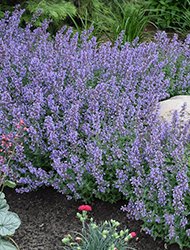
Catmint is a common mint that has a lot of blue flowers and is used a lot. One of the reasons I like this plant is that it is one of the earliest Xeriscape plants that bloom in the spring and form an attractive cluster of blue-green foliage. Another reason I like it is that it remains throughout the summer and doesn’t need to be maintained.
Iceplant:
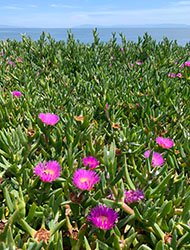
The Iceplant we use in Colorado is a perennial native to South Africa’s higher elevations. It is 6 to 8 inches tall. Keep in mind that this is not the invasive Iceplant that is a problem in Southern California. Delospermas produce a ground-hugging mat of green-to-grey succulent leaves. The plants are covered in delicate, shiny flowers that range in color from pink to red to purple to pink, often with centers of different colors.
Blue Avena grass:
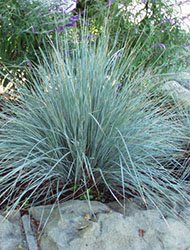
This grassy plant is a well-known xeric gardener’s favourite, drought-tolerant grass with gray-blue leaves that serve as the base for enormous flower spikes that bloom in full force by midsummer. To give your landscape a distinctive texture and colour, plant it with other xeriscape plants.
Chocolate Flower:
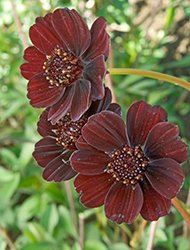
The milk chocolate aroma of this extremely drought-tolerant plant having 1 to 2 feet height, will blow your mind. Chocolate Flower is especially strong in the morning. It thrives in full sun and demonstrates its adaptability throughout Colorado. These yellow daisy-like flowers repel deer while attracting birds, butterflies, and bees.
Xeriscape plants for Florida:
Xeriscape plants, also known as Florida-friendly landscape plants in Florida are now in trend. So if you want a trendy and colorful landscape with minimal effort and irrigation cost, we’ve got you covered. We have some stupendous ideas for xeriscape plants that you can easily grow in your front yard and give your landscape an extravagant appeal.
Here are the best xeriscape plants for your Floridian yard:
Blanket Flower:
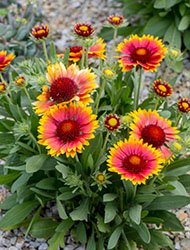
Gaillardia, also known as blanket flower, is a perennial that looks like a daisy and is easy to grow. It has a shorter lifespan. The plant gets its name due to its propensity to spread throughout an area.
The growth of blanket flowers is rapid. The plants reach a width of approximately 20 inches and a height of approximately 24 inches.
Bird of paradise:
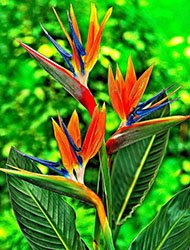
This xeriscape plant has propeller-shaped, emerald-green foliage surrounding stunning, vibrant orange and midnight-blue flowers that resemble the face of a colourful crane. They will definitely give your landscape that lush, tropical look.
Beautyberry:
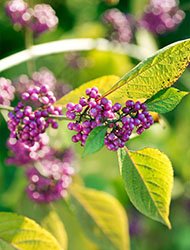
This shrub can only thrive in fertile, somewhat acidic soil with full to some sun. It features pale pink blossoms, but the berries, which appear to grow in clusters and bring color to your landscape, are a shade of lavender. The beautyberry can reach heights of 4 to 5 feet.
Buttonwood:
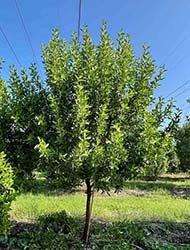
Buttonwood is a beautiful accent tree with silvery leaves that will stand out in a xeriscape that is mostly green. They can grow in partial shade, but they need full sun to retain their silver color. They can reach heights of 10 to 20 feet and are drought-tolerant, allowing them to easily withstand dry spells.
Green Island Ficus:
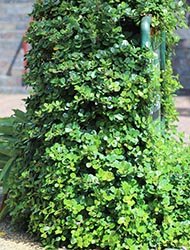
This is a small shrubby plant that needs very little to no maintenance. Green Island Ficus (Ficus microcarpa) can be kept rather small with the proper pruning because it grows slowly. It can survive in full sun, some shade, or both. It can withstand salt as well.
Frangipani tree:
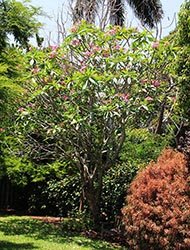
A frangipani tree is a wonderful option if you want to add exotic, vibrant trees to your yard. Red, pink, yellow, and other coloured flowers emerge in late spring and last through the summer. It can readily grow to a height of 20 feet in full sunlight and well-draining soil.
Desert Rose:
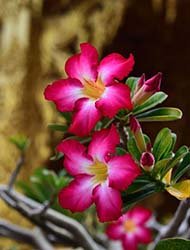
Desert-Rose is a succulent plant that likes a lot of sun and high temperatures. They must be grown in soil that drains well. Pink, red, and white blooms can be seen during the warmer months. They can reach a height of 4 feet, but the leaves may drop in the winter.
Crown-of-Thorns:
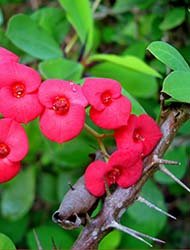
If you like red blooms, Crown of Thorns is the plant for you. It will produce them from spring until summer is over. It doesn’t need a lot of water because it’s a succulent, but it does best in indirect light. Additionally, temperatures below 60 degrees Fahrenheit discourage its growth.
Yellow pine:
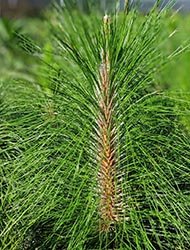
The yellow pine (Pinus palustris) is a tree that, if given enough room, can easily reach heights of more than 100 feet and widths of more than 40 feet. It grows best in full sunlight, but it can survive in some shade. It thrives in hot, humid environments, but well-drained soil is required.
Orange-Geiger-Tree:
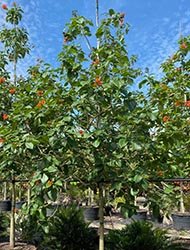
This tree will do a great job of attracting hummingbirds to your garden with its bright orange blooms. It is a plant that requires little upkeep and can reach 20 feet in height. Although it can handle salt, it will need to be protected from strong winds. To grow, it needs full or partial sun.
Xeriscape plants for Texas:
Although xeriscape plants are not new, they are becoming increasingly popular due to regional water constraints and a rise in the number of dry seasons in Texas. The goal of this style of landscaping is to introduce and utilize locally adapted plant species that will minimize the need for irrigation in individual homes.
Desert Willow:

It blooms from spring through summer and grows swiftly. This plant has a spread of 15 to 25 feet and a height of 15 to 25 feet. The desert willow thrives in locations with direct sunlight.
Bat-Faced Cuphea:
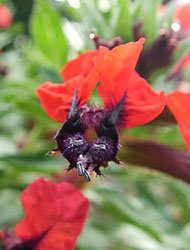
This plant derives its name from the winged creature that its scarlet and purple blossoms resemble. It tolerates heat and requires full to partial light. About a foot tall and wide, the Bat-Faced Cuphea grows.
Black-Eyed Susan:
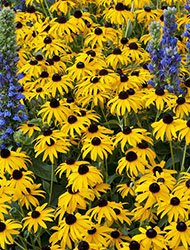
This perennial grows well from Central Texas to Houston and produces big yellow blooms. It has a height and spread of one to two feet and requires winter pruning.
Texas Redbud:
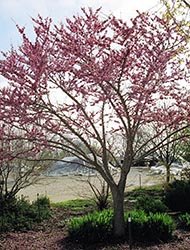
This tree can reach a height of 15 to 20 feet and produce white, the rarest of flowers, pink, or purple.
Lantana in the Trail:
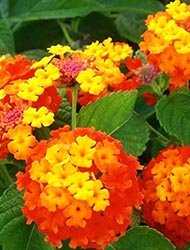
It is beneficial for all parts of Texas and produces orange and yellow flowers from summer to fall. It has a spread of 5 to 7 feet and a height of 4 to 6 feet.
Red Yucca:
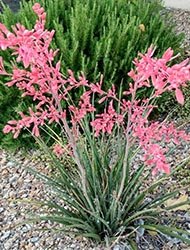
It grows to a height of 6 feet and a spread of 4 feet, adding color to your xeriscape. However, they are not suitable for pedestrian areas.
Gulf Muhly:
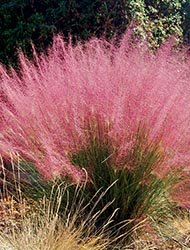
In the fall, the pink, feathery seed heads of this ornamental grass add color. They can be 2 to 2 1/2 feet tall with a spread of 2 to 3 feet.
Purple Heart:
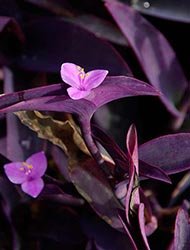
This plant, which has small, dark pink flowers and purple leaves, will die back in the winter and reappear in the spring. It works best in areas that don’t require much upkeep, like rock gardens and mixed borders. The Purple Heart can spread and reach heights of 12 to 18 inches.
Sedum:
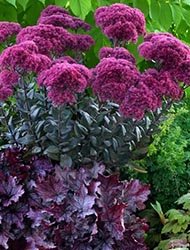
Sedum comes in many different varieties, some of which are ideal for rock gardens. They can be as small as 2 inches or as tall as 2 feet, making the smaller varieties an excellent choice for use as a groundcover.
Texas Sage:
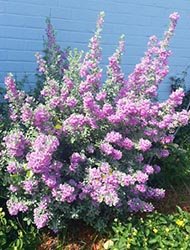
This shrub has a height and spread of 4 to 5 feet and produces numerous purple flowers throughout the year. It works best in Central Texas, but it can also be used in Houston.

